Definition: The instrument which uses the rectifying element for measuring the voltage and current is known as the rectifying instruments. The rectifying element converts the alternating current to the direct current which indicates by the DC responsive meter. The PMMC uses as an indicating instrument.
The sensitivity of the rectifying instruments is high as compared to the moving coil and the Electrodynamometer instrument. Thereby, it uses for measuring the current and voltage. The circuit arrangement of the rectifier instrument shown in the figure below. The device uses the four diodes which act as a rectifying element.
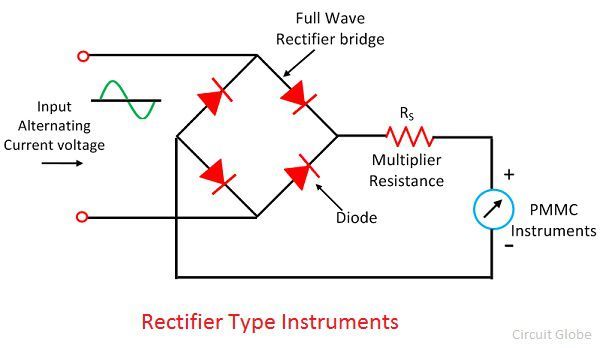 The multiplier resistance Rs uses for limiting the value of current so that their value does not extend more than the rating of the PMMC instrument.
The multiplier resistance Rs uses for limiting the value of current so that their value does not extend more than the rating of the PMMC instrument.
Rectifying Element
The rectifier element is used for the conversion of the AC to DC so that the unidirectional current flows through the PMMC instrument. The copper oxide, selenium cell, germanium and silicon diode are uses for making rectifying element.
The rectifying element offers the zero resistance when it is in forwarding bias and infinite resistance when it is in reverse biased. This property of the rectifying element use for rectification purpose.
Characteristic Curve of Rectifying Element
The characteristic curve of the rectifying circuit shown in the figure below. Ideally, the rectifying instrument does not have any voltage drops in the forward direction and no current flows in the reverse direction. But practically, this is not possible. The real characteristic curve of the rectifying element shown in the figure below.
But practically, this is not possible. The real characteristic curve of the rectifying element shown in the figure below.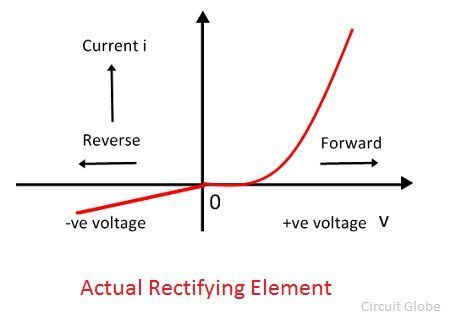
Half Wave Rectifier Circuit
The figure below shows the half-wave rectifying circuit. The rectifying element connects in series with the voltage source, resistance multiplier and the permanent moving coil instrument. The forward resistance of the diode is neglected.
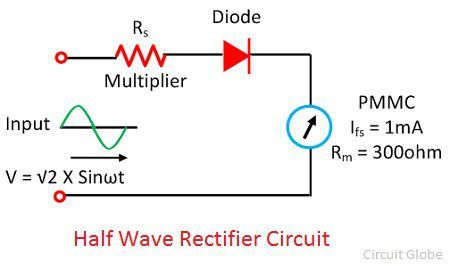 When the DC voltage source applies to the circuit, the Im current flows through it. The magnitude of the current is equal to the V/(Rm+RS). The current shows the full-scale deflection to the instrument.
When the DC voltage source applies to the circuit, the Im current flows through it. The magnitude of the current is equal to the V/(Rm+RS). The current shows the full-scale deflection to the instrument.
The AC voltage applies to the same circuit. The rectifying element converts the AC voltage into unidirectional DC voltage. Thus, the rectified output voltage obtains through the rectify instrument. The PMMC instrument deflects through the average value of current which depends on the average voltage of the apparatus.
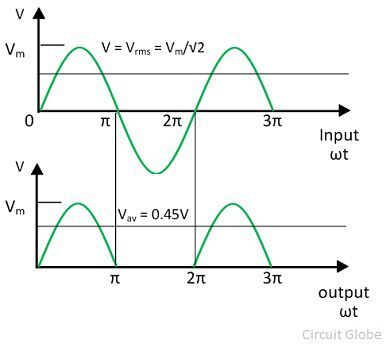 Average Value of Voltage
Average Value of Voltage The above calculation shows that the sensitivity of the instrument through AC is 0.45 times the current through the sensitivity of DC.
The above calculation shows that the sensitivity of the instrument through AC is 0.45 times the current through the sensitivity of DC.
Full Wave Rectifier Instrument
The circuit of full wave rectifier shown in the figure below.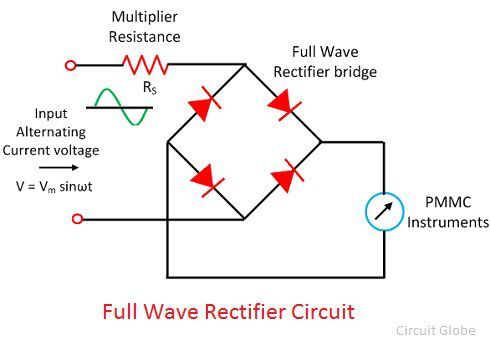 The DC voltage applied to the circuit causes the full-scale deflection of the PMMC meter. The sinusoidal voltage applies to the meter express as
The DC voltage applied to the circuit causes the full-scale deflection of the PMMC meter. The sinusoidal voltage applies to the meter express as
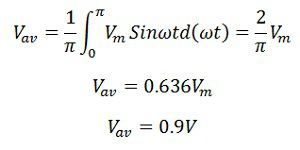 The average calculation of AC is 0.9 times with that of the DC for the same value of voltage. Or we can say that the sensitivity of the instrument along with AC is 90% with that of the DC.
The average calculation of AC is 0.9 times with that of the DC for the same value of voltage. Or we can say that the sensitivity of the instrument along with AC is 90% with that of the DC. The sensitivity of the full wave rectifier is double to that of the half wave rectifier instrument.
The sensitivity of the full wave rectifier is double to that of the half wave rectifier instrument.
Sensitivity of Rectifier Instrument
The sensitivity of the instrument shows the variation of the measured quantity from input to output. The DC sensitivity of the rectifier instrument
 The sensitivity of the AC rectifier type instrument depends on the type of the rectifying element use in the circuit.
The sensitivity of the AC rectifier type instrument depends on the type of the rectifying element use in the circuit.
Factors Affecting the Performance of Rectifier Type Instruments
The following are the factors that affect the performance of the instrument when it is used on AC.
- Effects of Waveform – The calibration of the rectifier instrument can be done regarding the RMS value of voltage and current. The form factor of the half wave and the full wave rectifier type instrument fixes on the calibrated scale. And if the waveform of the other form factors applies to the device, the waveform error occurs in the reading.
- Effect of Temperature Change – The resistance of the rectifying element varies with the change in temperature. And this property of the rectifying component causes the error in the instruments.
- Effect of Rectifying Instrument – The rectifier instrument has the property of the imperfect capacitance. It allows the high-frequency current to pass through it.
- Decreases in Sensitivity – The sensitivity of the rectifier type instrument for AC operation is lower than that of the DC operation.
Advantages of Rectifying Instrument
The following are the advantages of the rectifiers instruments.
- The frequency range of the instruments increases from 20HZ to high-frequency range.
- The current operating range for such type of instrument is much lower for voltmeter as compared to the other AC instrument.
- The instrument has uniform scales for the large range.
- The accuracy of the instrument is ±5 percent when it is in normal operating condition.
Applications of Rectifying Instrument
The following are the applications of the rectifying instrument.
- The instrument uses for measuring the voltage whose range lies between 50 – 250 V.
- It use as a milliammeter or micro-ammeter.
- The rectifying instrument use in the communication circuit for measurement.
The sensitivity of the rectifying type voltmeter is less than that the sensitivity of the DC voltmeter. Thus, the loading effect of the ac rectifier voltmeter is higher than the dc voltmeter.

realy it is useful